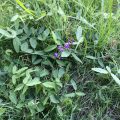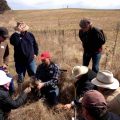Renovating Creek Lines After Flood!
Published 24th February 2023. Written by Maddison O’Brien
Recent flooding has destroyed fence lines, eroded creek banks and created bare soil around our waterways. This destruction creates a lot of work and expense for landholders fixing fences and figuring out what to do about the devastating effects of water erosion. It’s a mammoth task, and while overwhelming as it may seem, there are opportunities here to make the work we do meet many different needs to improve the productivity and resilience of our landscape.
When repairing fences, are there ways to improve their location and function in the landscape? Landholders are encouraged to rethink fence lines to best suit their enterprise, grazing system, water supply and livestock access. Allowing stock to access waterways further directly accelerates erosion. Studies show that stock will select to drink from a trough rather than a dam as the water is cleaner and easier to access. Livestock will drink more water if it is of high quality, leading them to eat more dry matter and gain weight.
Native vegetation may re-seed after a flood and provide valuable shade and shelter for livestock. Allowing space for this may mean fencing off some areas from stock or using temporary fencing while these areas rejuvenate.

Recent Floods have left many waterways in a damaged state, steps to remediate this can have long term benefits to farm resilience.
Loss of vegetation around our streams and rivers due to erosion from flooding is also widespread. Planting with native species may be an option suitable for your landscape. Replanting along the banks of waterways can be hugely beneficial to water quality and provides habitat for a vast range of species, giving biodiversity benefits to our farms. Whilst the flooding has wiped out a lot of native vegetation, weeds have been cleared in some cases, providing an ideal opportunity to plant out with species we do want. With this ease of access and abundant access to water, the Autumn & Spring of 2023 look like ideal windows of opportunity to get some planting done.
We can be strategic with planting to maximise benefits to productivity. Perhaps there are areas near creeks that are sometimes too boggy to graze. These swampy areas would be wise to target with planting to reduce water saturation and create some patches of vegetation that can be short-term grazed in drier times. These new plantings will also be useful pockets of habitat for wildlife. Pollination is also something to consider. If you have crops, you can select species with high value to native pollinators to support their numbers, which will also benefit your crop pollination.
The aim here is to promote farm recovery and long-term resilience, and all this considered, plans must be practical and match your financial circumstances. Even small steps we take to be more prepared for future floods can impact how our farms recover.







